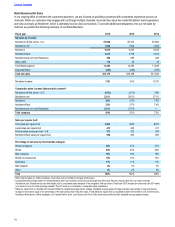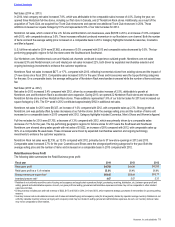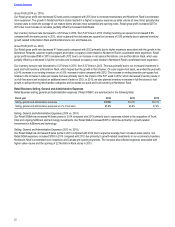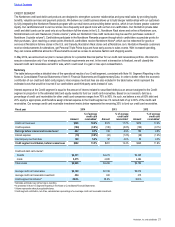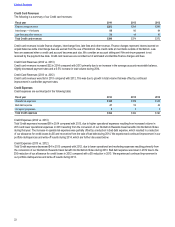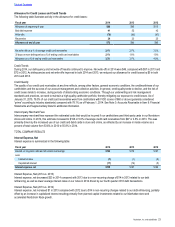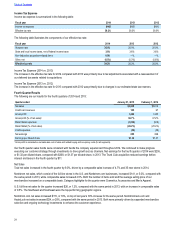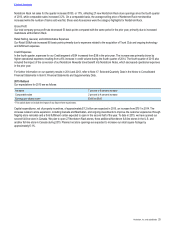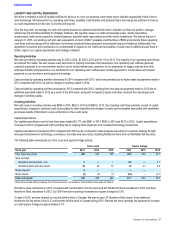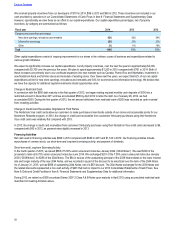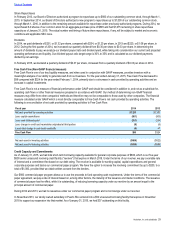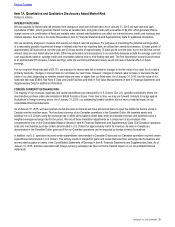Nordstrom 2014 Annual Report Download - page 28
Download and view the complete annual report
Please find page 28 of the 2014 Nordstrom annual report below. You can navigate through the pages in the report by either clicking on the pages listed below, or by using the keyword search tool below to find specific information within the annual report.
Table of Contents
28
We received property incentives from our developers of $110 in 2014, $89 in 2013 and $58 in 2012. These incentives are included in our
cash provided by operations in our Consolidated Statements of Cash Flows in Item 8: Financial Statements and Supplementary Data.
However, operationally we view these as an offset to our capital expenditures. Our capital expenditure percentages, net of property
incentives, by category are summarized as follows:
Fiscal year 2014 2013 2012
Category and expenditure percentage:
New store openings, relocations and remodels 62% 62% 54%
Information technology 35% 27% 27%
Other 3% 11% 19%
Total 100% 100% 100%
Other capital expenditures consist of ongoing improvements to our stores in the ordinary course of business and expenditures related to
various growth initiatives.
We expect to significantly increase our capital expenditures, net of property incentives, over the next five years to approximately $4,300,
compared with $2,700 over the previous five years. We plan to spend approximately $1,200 in 2015 compared with $751 in 2014. Both of
these increases are primarily due to our continued expansion into new markets such as Canada, Puerto Rico and Manhattan, investment in
new Nordstrom Rack and full-line stores and remodels of existing stores. Over these next five years, we expect that 62% of our net capital
expenditures will be for new store openings, relocations and remodels and 34% for ecommerce and information technology. We believe that
we have the capacity for additional capital investments should opportunities arise.
Change in Restricted Cash
In connection with the $500 debt maturity in the first quarter of 2012, we began making required monthly cash deposits of $100 into a
restricted account in December 2011 until we accumulated $500 by April 2012 to retire the debt. As of January 28, 2012, we had
accumulated $200. During the first quarter of 2012, the net amount withdrawn from restricted cash of $200 was recorded as cash received
from investing activities.
Change in Credit Card Receivables Originated at Third Parties
The Nordstrom Visa credit cards allow our customers to make purchases at merchants outside of our stores and accumulate points for our
Nordstrom Rewards program. In 2014, the change in credit card receivables from customers’ third-party purchases using their Nordstrom
Visa credit cards was relatively flat compared with 2013.
In 2013, the change in credit card receivables from customers’ third-party purchases using their Nordstrom Visa credit cards decreased to $6,
compared with $42 in 2012, as payment rates slightly increased in 2013.
Financing Activities
Net cash used in financing activities was $698 in 2014 compared with $589 in 2013 and $1,333 in 2012. Our financing activities include
repurchases of common stock, our short-term and long-term borrowing activity, and payment of dividends.
Short-term and Long-term Borrowing Activity
In the fourth quarter of 2013, we issued $665 of 5.00% senior unsecured notes due January 2044 (“2044 Notes”). We used $400 of the
proceeds to retire all 6.75% senior unsecured notes due June 2014. We exchanged $201 of the 7.00% senior unsecured notes due January
2038 (“2038 Notes”) for $265 of the 2044 Notes. The $64 in excess of the outstanding principal of the 2038 Notes relates to the lower interest
rate and longer maturity of the new 2044 Notes, and we recorded it as part of the discount to be amortized over the term of the 2044 Notes.
As of January 31, 2015, we had $598 of outstanding 2044 Notes, net of a $67 discount. The 2044 Notes exchanged for the 2038 Notes and
the related discounts represented a non-cash activity of $201 that had no impact to our 2013 Consolidated Statements of Cash Flows. See
Note 8: Debt and Credit Facilities in Item 8: Financial Statements and Supplementary Data for additional information.
During 2012, we retired our $500 securitized Series 2007-2 Class A & B Notes upon maturity in April 2012 using accumulated restricted cash
described in Investing Activities above.


